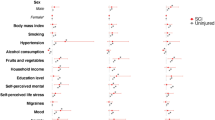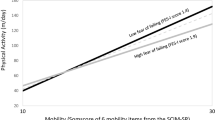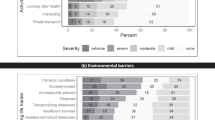Abstract
Study design:
This was a prospective cross-sectional study for people with chronic spinal cord injury (SCI).
Objectives:
To (1) evaluate the intensity level and nature of physical activity in community-dwelling individuals living with SCI, and (2) explore the relation between descriptive individual variables (for example, lesion level), secondary complications and participation in physical activity.
Setting:
Urban community setting.
Methods:
A total of 49 subjects with SCI who used a manual wheelchair for primary mode of mobility (mean years since injury, 11.8; mean age, 43.7 years; 67% paraplegia) completed the physical activity recall assessment for people with SCI (PARA-SCI).
Results:
Approximately 50% of reported physical activity among individuals with SCI is due to activities of daily living. The amount of physical activity was not related to lesion level, age, body mass index or waistline size. Greater heavy-intensity activity was related to lower levels of pain and fatigue and higher levels of self-efficacy, whereas higher amounts of mild-intensity activity and total activity were related to less depressive symptoms.
Conclusions:
Activities of daily living are a large component for physical activity among individuals with SCI. It appears that greater physical activity is associated with less secondary complications (pain, fatigue and depression) in individuals with SCI.
Similar content being viewed by others
Log in or create a free account to read this content
Gain free access to this article, as well as selected content from this journal and more on nature.com
or
References
Dearwater SR, LaPorte RE, Cauley JA, Brenes G . Assessment of physical activity in inactive populations. Med Sci Sports Exerc 1985; 17: 651–655.
Buchholz AC, McGillivray CF, Pencharz PB . Physical activity levels are low in free-living adults with chronic paraplegia. Obes Res 2003; 11: 563–570.
Martin Ginis KA, Latimer AE, Hicks AL, Craven BC . Development and evaluation of an activity measure for people with spinal cord injury. Med Sci Sports Exerc 2005; 37: 1099–1111.
Ashe MC, Eng JJ, Miller WC, Soon JA . Disparity between physical capacity and participation in seniors with chronic disease. Med Sci Sports Exerc 2007; 39: 1139–1146.
Rosemann T, Kuehlein T, Laux G, Szecsenyi J . Osteoarthritis of the knee and hip: a comparison of factors associated with physical activity. Clin Rheumatol 2007; 26: 1811–1817.
Rosqvist E, Heikkinen E, Lyyra TM, Hirvensalo M, Kallinen M, Leinonen R et al. Factors affecting the increased risk of physical inactivity among older people with depressive symptoms. Scand J Med Sci Sports 2008 (e-pub ahead of print).
Galper DI, Trivedi MH, Barlow CE, Dunn AL, Kampert JB . Inverse association between physical inactivity and mental health in men and women. Med Sci Sports Exerc 2006; 38: 173–178.
Miller WC, Anton HA, Townson AF . Measurement properties of the CESD scale among individuals with spinal cord injury. Spinal Cord 2008; 46: 287–292.
Cerin E, Vandelanotte C, Leslie E, Merom D . Recreational facilities and leisure-time physical activity: an analysis of moderators and self-efficacy as a mediator. Health Psychol 2008; 27: S126–S135.
Janssen TW, van Oers CA, van der Woude LH, Hollander AP . Physical strain in daily life of wheelchair users with spinal cord injuries. Med Sci Sports Exerc 1994; 26: 661–670.
Latimer AE, Martin Ginis KA, Craven BC, Hicks AL . The physical activity recall assessment for people with spinal cord injury: validity. Med Sci Sports Exerc 2006; 38: 208–216.
Herlofson K, Larsen JP . Measuring fatigue in patients with Parkinson's disease—the Fatigue Severity Scale. Eur J Neurol 2002; 9: 595–600.
Von Korff M, Ormel J, Keefe FJ, Dworkin SF . Grading the severity of chronic pain. Pain 1992; 50: 133–149.
Raichle KA, Osborne TL, Jensen MP, Cardenas D . The reliability and validity of pain interference measures in persons with spinal cord injury. J Pain 2006; 7: 179–186.
Cohen S, Mermelstein R, Kamarck T, Hoberman HM . Measuring the functional components of social support. In: Sarason IG, Sarason BR (eds). Social Support: Theory, Research, and Applications. Martinus Nijhoff: The Hague, Netherlands. 1985, pp 73–94.
Lorig KR, Sobel DS, Ritter PL, Laurent D, Hobbs M . Effect of a self-management program on patients with chronic disease. Eff Clin Pract 2001; 4: 256–262.
Pallant J, Pallant JF . In: SPSS Survival Manual: A Step by Step Guide to Data Analysis Using SPSS. Allen & Unwin, Open University Press: Berkshire, UK, 2007.
Ackery A, Tator C, Krassioukov A . A global perspective on spinal cord injury epidemiology. J Neurotrauma 2004; 21: 1355–1370.
Boey KW . Cross-validation of a short form of the CES-D in Chinese elderly. Int J Geriatr Psychiatry 1999; 14: 608–617.
Motl RW, Snook EM, McAuley E, Scott JA, Douglass ML . Correlates of physical activity among individuals with multiple sclerosis. Ann Behav Med 2006; 32: 154–161.
Acknowledgements
We thank Dr Yen-Ho Wang, Mrs Yueh-Er Lee and Ms Zu-Si Lei for subject recruitment; Ms Ron-Jyuan Liing, Ms Yin-Chen Chen and Mr Li-Hsueh Chen for data collection; the National Science Council (no. NSC 96-2811-B-002-001, Taiwan) and the International Collaboration on Repair Discovery for visiting professor awards (to JJE) and Canadian Institutes for Health Research and the Michael Smith Foundation for Health Research for career scientist awards (to JJE).
Author information
Authors and Affiliations
Corresponding author
Rights and permissions
About this article
Cite this article
Tawashy, A., Eng, J., Lin, K. et al. Physical activity is related to lower levels of pain, fatigue and depression in individuals with spinal-cord injury: a correlational study. Spinal Cord 47, 301–306 (2009). https://doi.org/10.1038/sc.2008.120
Received:
Revised:
Accepted:
Published:
Issue date:
DOI: https://doi.org/10.1038/sc.2008.120
Keywords
This article is cited by
-
Correlates of adherence in a home-based, self-managed exercise program tailored to wheelchair users with spinal cord injury
Spinal Cord (2021)
-
A tele-health intervention to increase physical fitness in people with spinal cord injury and cardiometabolic disease or risk factors: a pilot randomized controlled trial
Spinal Cord (2021)
-
Supporting front crawl swimming in paraplegics using electrical stimulation: a feasibility study
Journal of NeuroEngineering and Rehabilitation (2020)
-
Lifestyle modifications and pharmacological approaches to improve sexual function and satisfaction in men with spinal cord injury: a narrative review
Spinal Cord (2020)
-
Reliability and validity of the Persian version of the spinal cord injury lifestyle scale and the health behavior questionnaire in persons with spinal cord injury
Spinal Cord (2018)



